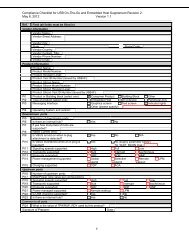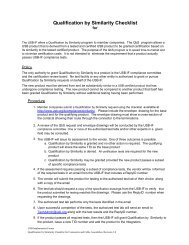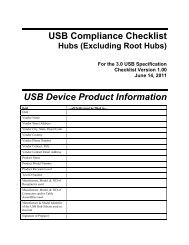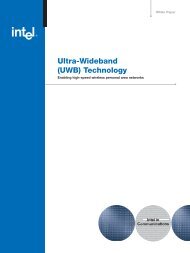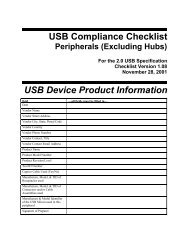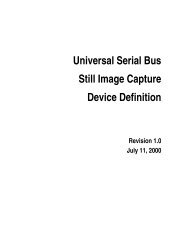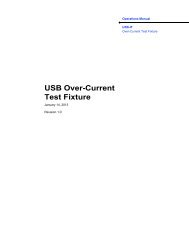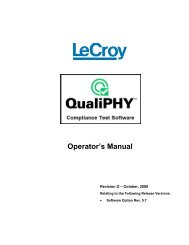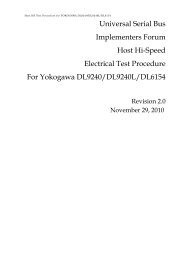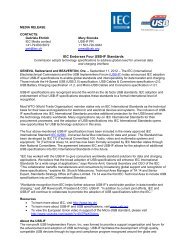Create successful ePaper yourself
Turn your PDF publications into a flip-book with our unique Google optimized e-Paper software.
104 <strong>HID</strong> <strong>Sensor</strong> <strong>Usage</strong>s<br />
o Performing a <strong>HID</strong> Get Input Report request to retrieve a single “table row” consisting of<br />
the GUID_OR_PROPERTYKEY struct;<br />
o After each <strong>HID</strong> Get Input Report request, the sensor firmware automatically increments<br />
the <strong>HID</strong>_USAGE_SENSOR_DATA_ENUMERATOR_TABLE_ROW_INDEX.<br />
Once this operation is complete, the platform driver will now know:<br />
The top level collection number (from 2 to n) of every sensor represented by the device;<br />
The <strong>Sensor</strong> Category and <strong>Sensor</strong> Type of each sensor;<br />
The <strong>Sensor</strong> Events emitted by each sensor;<br />
All of the Data Fields reported by each sensor; and for each of those Data Fields, its Report ID,<br />
packing position, data type, size, unit of measure, and so on;<br />
All of the Properties supported by each sensor; and for each of those Properties, its Report ID,<br />
packing position, data type, size, unit of measure, and so on.<br />
When the platform driver wishes to interpret any Data Field or Property, it has all the information it needs<br />
without requiring any of the identifying information to be “inline” in the Reports themselves. This frees up<br />
the entire packet (other than the single byte for the Report ID) for holding the data values.<br />
Here is an example of a <strong>HID</strong> Report Descriptor illustrating this concept:<br />
// Complete <strong>HID</strong> report descriptor<br />
const unsigned char enum_sensor_report_descriptor[] = {<br />
<strong>HID</strong>_USAGE_PAGE_SENSOR,<br />
<strong>HID</strong>_USAGE_SENSOR_TYPE_COLLECTION<br />
<strong>HID</strong>_COLLECTION(Application),<br />
};<br />
// Global items<br />
<strong>HID</strong>_REPORT_SIZE(8),<br />
<strong>HID</strong>_LOGICAL_MIN_8(0),<br />
<strong>HID</strong>_LOGICAL_MAX_8(255),<br />
// Report ID 0x08: an Input Report with 37 bytes of Data Fields<br />
<strong>HID</strong>_REPORT_ID(0x08),<br />
<strong>HID</strong>_USAGE_SENSOR_DATA_GENERIC_DATAFIELD,<br />
<strong>HID</strong>_REPORT_COUNT(37),<br />
<strong>HID</strong>_INPUT(Const_Arr_Abs),<br />
// Report ID 0x09: a Feature Report with 63 bytes of Read-Only Properties<br />
<strong>HID</strong>_REPORT_ID(0x09),<br />
<strong>HID</strong>_USAGE_SENSOR_DATA_GENERIC_PROPERTY,<br />
<strong>HID</strong>_REPORT_COUNT(63),<br />
<strong>HID</strong>_FEATURE(Const_Arr_Abs),<br />
// Report ID 0x0a: a Feature Report with 42 bytes of Read/Write Properties<br />
<strong>HID</strong>_REPORT_ID(0x0a),<br />
<strong>HID</strong>_USAGE_SENSOR_DATA_GENERIC_PROPERTY,<br />
<strong>HID</strong>_REPORT_COUNT(42),<br />
<strong>HID</strong>_FEATURE(Data_Arr_Abs),<br />
<strong>HID</strong>_END_COLLECTION<br />
Note from the above that the contents of the Input Reports and Feature Reports are completely opaque.<br />
The Generic Enumerator table rows must be consulted to make any sense out of the data values in the<br />
Reports. The advantage of this approach is that it allows complete “run time” flexibility in the semantics of<br />
the data being transferred.<br />
4.3 Illustrative <strong>Sensor</strong> Report Descriptors<br />
4.3.1 Biometric: Human Presence<br />
// Complete <strong>HID</strong> report descriptor<br />
//Human Presence<br />
const unsigned char pres_report_descriptor[] = {<br />
<strong>HID</strong>_USAGE_PAGE_SENSOR,<br />
<strong>HID</strong>_USAGE_SENSOR_TYPE_BIOMETRIC_PRESENCE,<br />
<strong>HID</strong>_COLLECTION(Physical),



